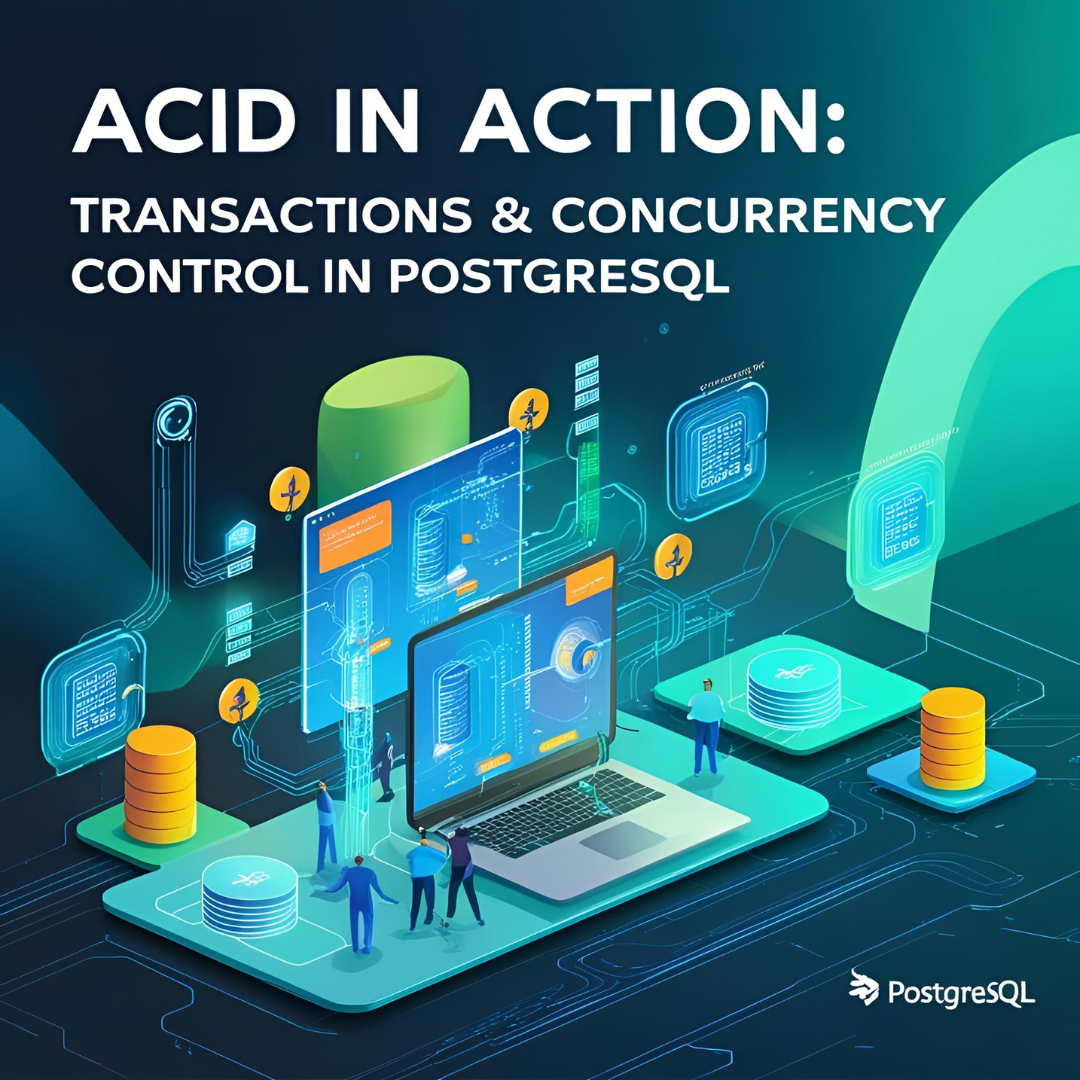In the world of database management systems, PostgreSQL stands as one of the most robust and reliable options available. A key reason for its dependability is its strict adherence to ACID principles and sophisticated concurrency control mechanisms. This post explores how PostgreSQL implements these critical aspects to ensure data integrity even in high-concurrency environments.
Understanding ACID Properties
ACID represents four essential properties that guarantee reliable transaction processing in database systems:
Atomicity
In PostgreSQL, a transaction is an all-or-nothing operation. Either all the operations within a transaction are completed successfully, or none are applied. For example:
BEGIN;
UPDATE accounts SET balance = balance - 1000 WHERE id = 1;
UPDATE accounts SET balance = balance + 1000 WHERE id = 2;
COMMIT;
If the second UPDATE fails for any reason (perhaps account #2 doesn’t exist), PostgreSQL will roll back the first UPDATE as well, ensuring no money “disappears” from the system.
Consistency
PostgreSQL ensures that a transaction brings the database from one valid state to another, maintaining all predefined rules such as constraints, cascades, and triggers. For instance, if a foreign key constraint exists, PostgreSQL won’t allow a transaction that would violate this constraint.
Isolation
Multiple transactions can occur simultaneously without interfering with each other. PostgreSQL provides several isolation levels:
- READ UNCOMMITTED (behaves like READ COMMITTED in PostgreSQL)
- READ COMMITTED (default)
- REPEATABLE READ
- SERIALIZABLE
Each level offers different guarantees regarding phenomena like dirty reads, non-repeatable reads, and phantom reads.
Durability
Once a transaction is committed, it remains so even in the event of power loss, crashes, or errors. PostgreSQL achieves this through Write-Ahead Logging (WAL), which records changes before they’re applied to the actual data files.
Concurrency Control Mechanisms in PostgreSQL
PostgreSQL employs several sophisticated techniques to handle concurrent access:
Multiversion Concurrency Control (MVCC)
Unlike traditional locking mechanisms, MVCC creates a “snapshot” of the database at the start of each transaction. This approach allows:
- Readers to not block writers
- Writers to not block readers
- Each transaction to see a consistent view of the database
When a row is updated in PostgreSQL, rather than overwriting the old version, a new version is created. The old version remains accessible to ongoing transactions that started before the update.
Transaction Isolation Levels
PostgreSQL’s isolation levels provide different trade-offs between consistency and performance:
- READ COMMITTED: Each query sees only data committed before the query began. This prevents dirty reads but allows non-repeatable reads and phantom reads.
- REPEATABLE READ: All queries in a transaction see data as it was at the start of the transaction. This prevents both dirty reads and non-repeatable reads but still allows phantom reads.
- SERIALIZABLE: The strongest isolation level, providing complete isolation. Transactions execute as if they were serialized one after another, preventing all concurrency anomalies.
Example of setting isolation level:
BEGIN;
SET TRANSACTION ISOLATION LEVEL SERIALIZABLE;
-- Transaction operations
COMMIT;
Handling Deadlocks
PostgreSQL automatically detects deadlocks (where two transactions are waiting for locks held by each other) and resolves them by aborting one of the transactions. The application can then retry the transaction:
BEGIN;
UPDATE accounts SET balance = balance - 100 WHERE id = 1;
-- If deadlock occurs here, PostgreSQL will abort this transaction
UPDATE accounts SET balance = balance + 100 WHERE id = 2;
COMMIT;
Advanced Concurrency Patterns
Advisory Locks
PostgreSQL provides application-level locks that can be used to coordinate activities not directly tied to database operations:
SELECT pg_advisory_lock(123); -- Acquire lock with ID 123
-- Critical section operations
SELECT pg_advisory_unlock(123); -- Release lock
Row-Level Locks
For more fine-grained control, PostgreSQL offers row-level locking:
BEGIN;
SELECT * FROM accounts WHERE id = 1 FOR UPDATE; -- Lock this row
-- Other operations
COMMIT; -- Release locks
Optimistic Concurrency Control
Using version columns or timestamps to detect conflicts:
BEGIN;
SELECT balance, version FROM accounts WHERE id = 1;
-- Application computes new balance
UPDATE accounts
SET balance = new_balance, version = version + 1
WHERE id = 1 AND version = old_version;
-- If no rows updated, conflict detected
COMMIT;
Best Practices for ACID Compliance in PostgreSQL
- Keep transactions short to minimize lock contention and improve concurrency.
- Choose appropriate isolation levels based on your application’s needs:
- Use READ COMMITTED for general-purpose work
- Use SERIALIZABLE only when strict consistency is required
- Handle serialization failures by retrying transactions, especially when using SERIALIZABLE isolation:
DO $$
BEGIN
FOR i IN 1..5 LOOP -- Try up to 5 times
BEGIN
-- Transaction code here
EXIT; -- Success, exit the loop
EXCEPTION WHEN serialization_failure THEN
-- Serialization failure, retry
CONTINUE;
END;
END LOOP;
END;
$$;
- Use explicit locking when necessary, but prefer PostgreSQL’s built-in MVCC when possible.
- Implement proper error handling to catch and recover from transaction failures.
Conclusion
PostgreSQL’s robust implementation of ACID properties and advanced concurrency control mechanisms make it an excellent choice for applications requiring high data integrity and concurrent access. By understanding these features, developers can build reliable applications that correctly handle simultaneous operations while maintaining data consistency.
Whether you’re developing a financial system that can’t afford to lose a single transaction or a high-traffic web application that needs to handle thousands of concurrent users, PostgreSQL provides the tools to ensure your data remains accurate and consistent.


Leave a Reply